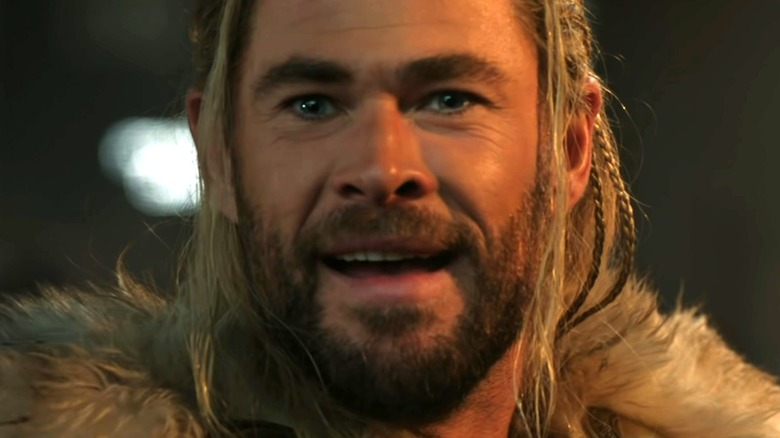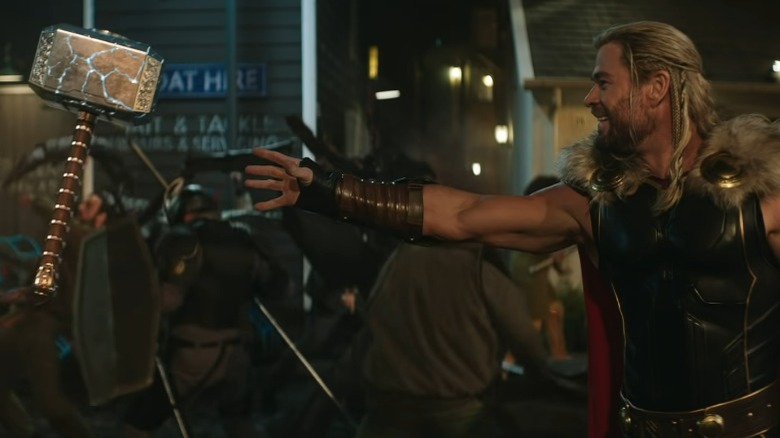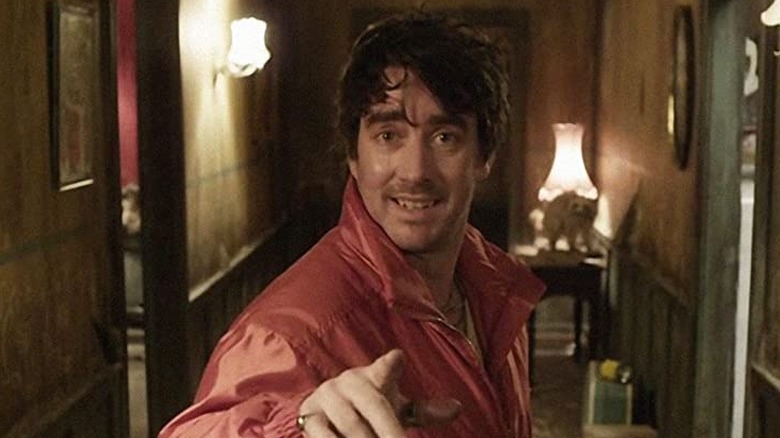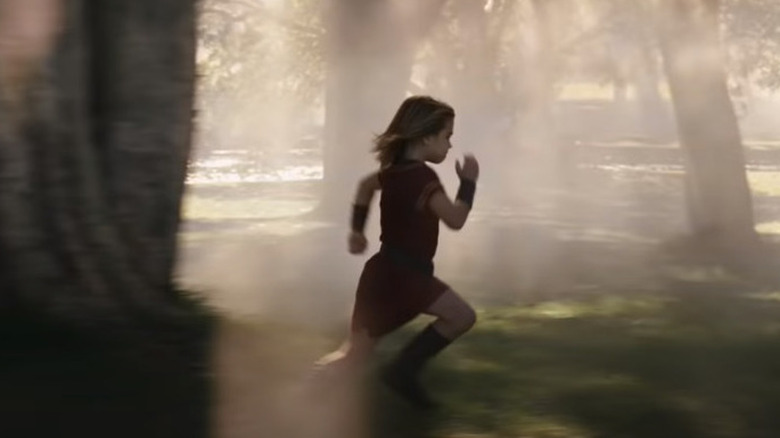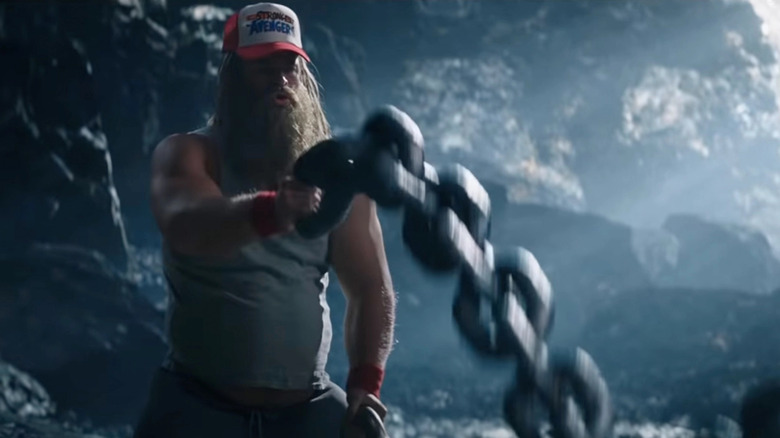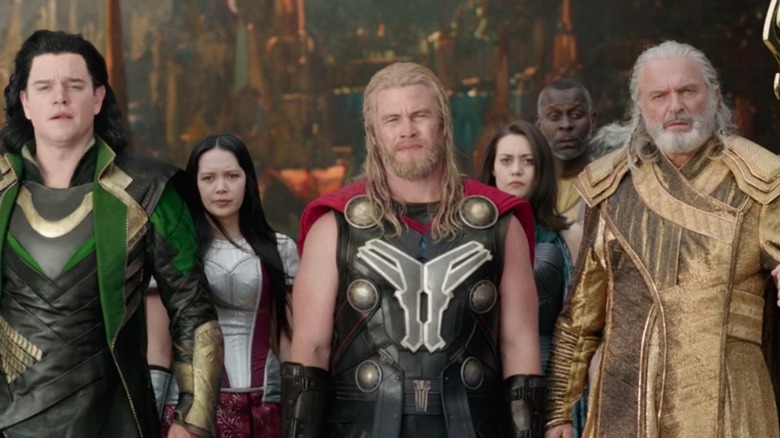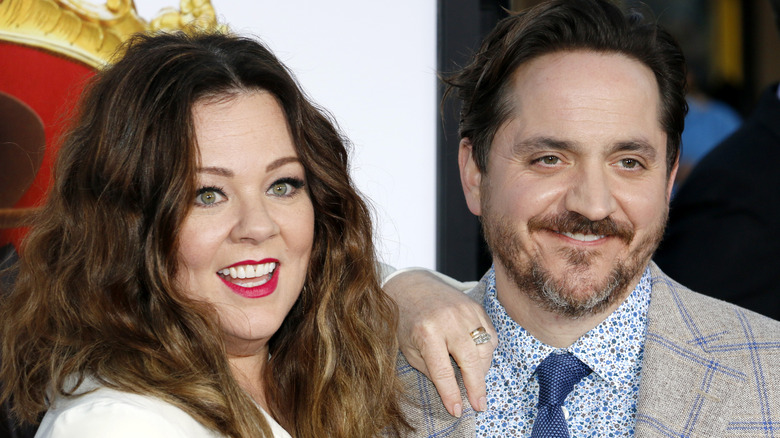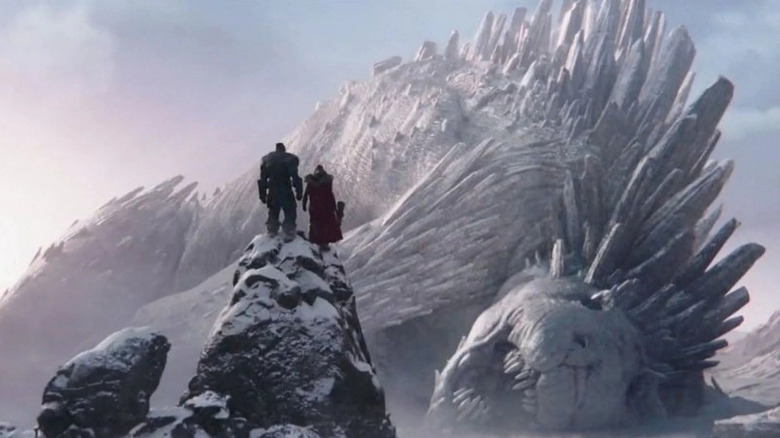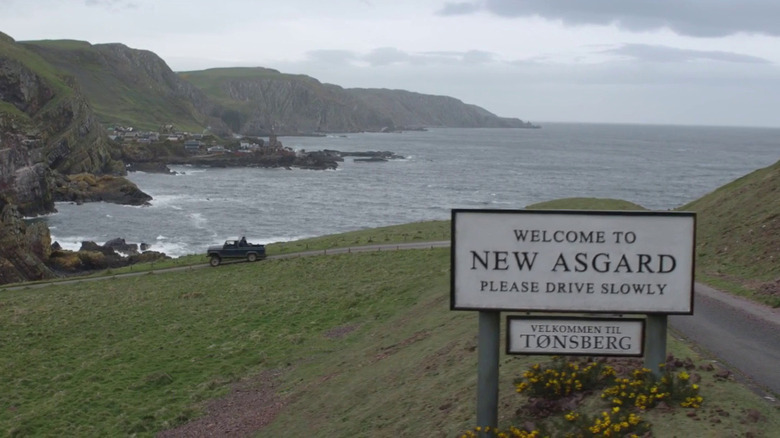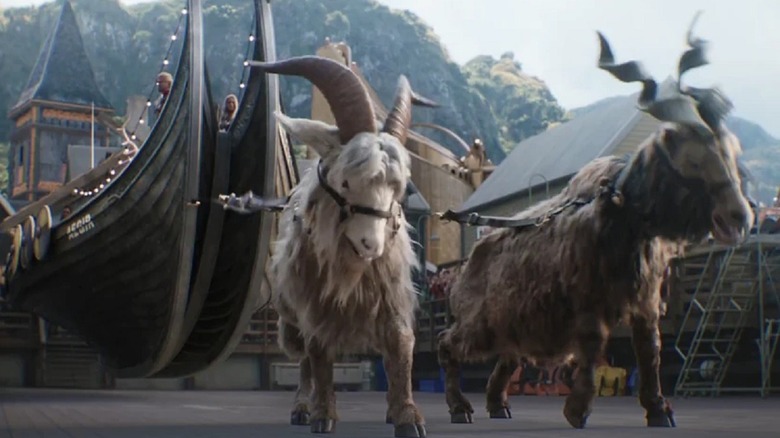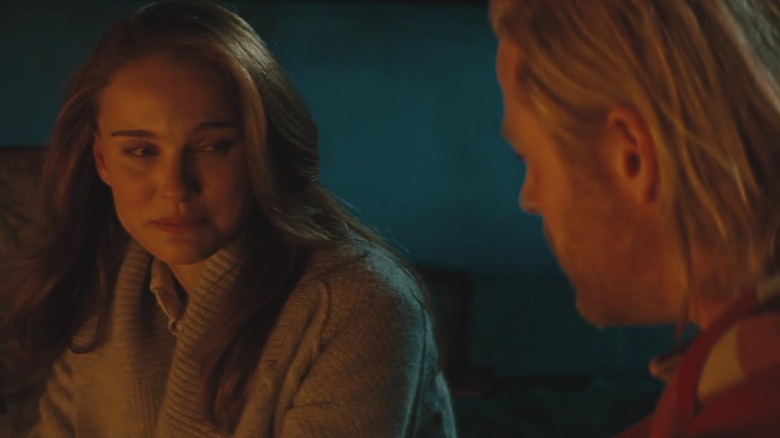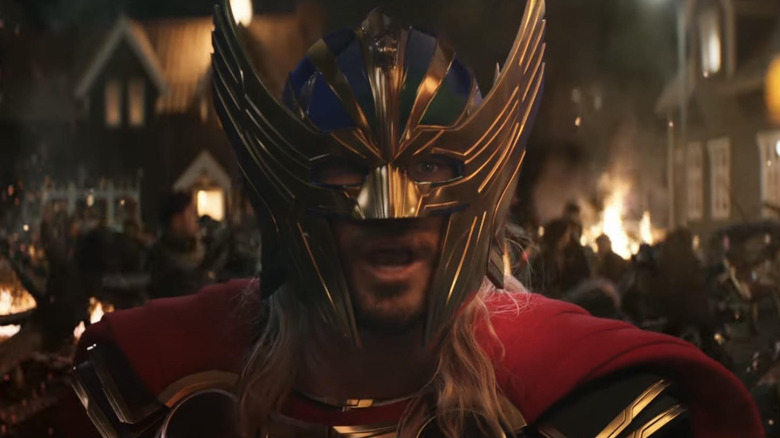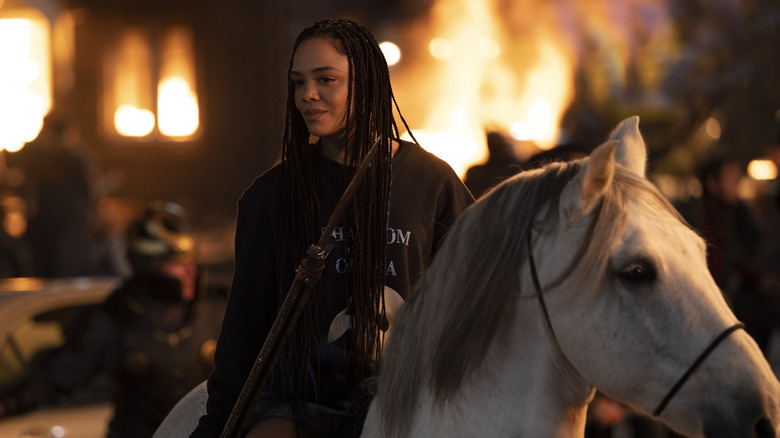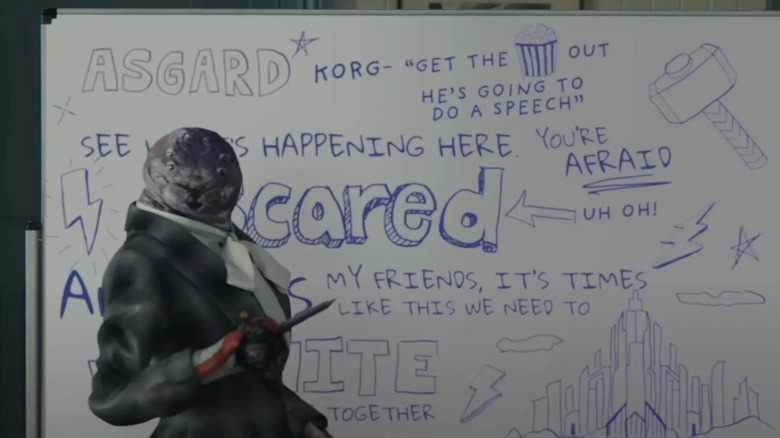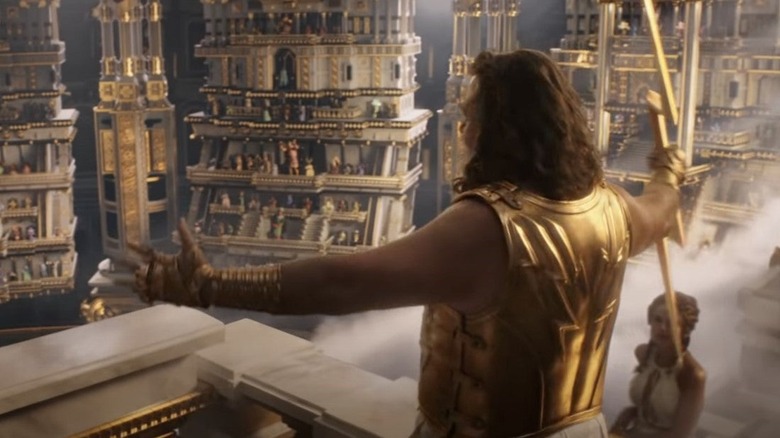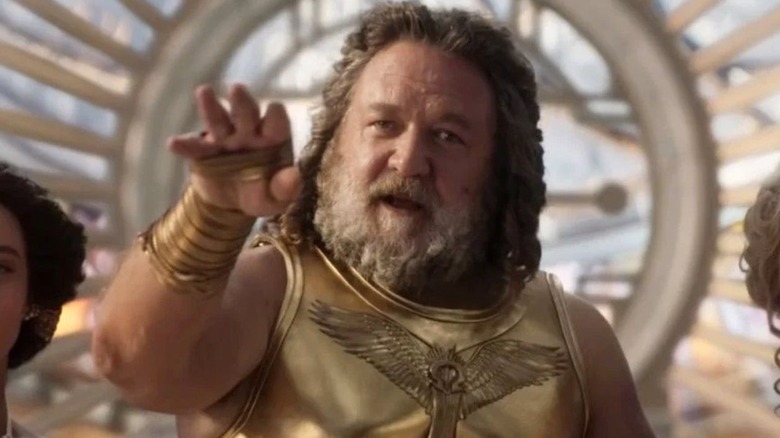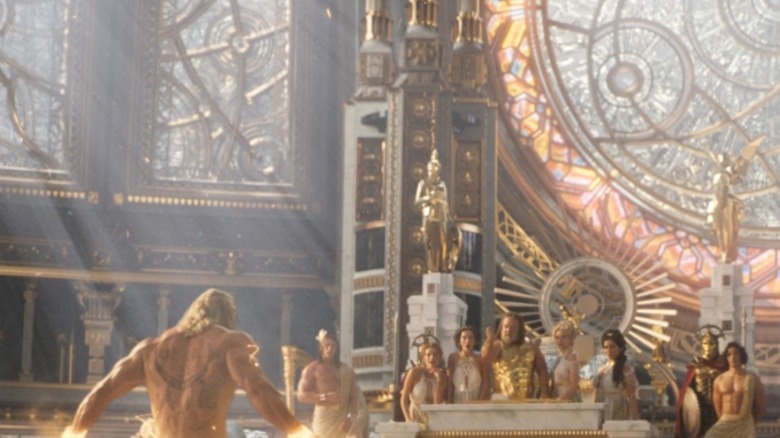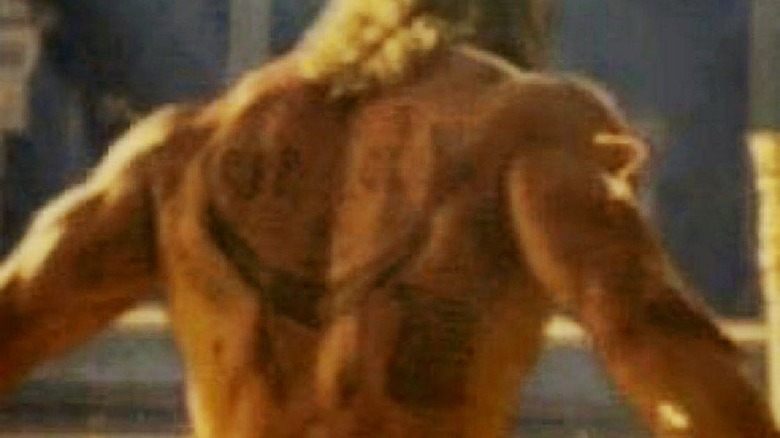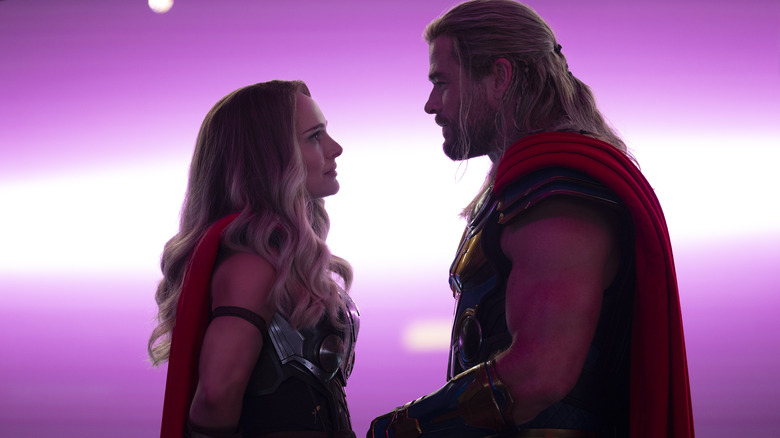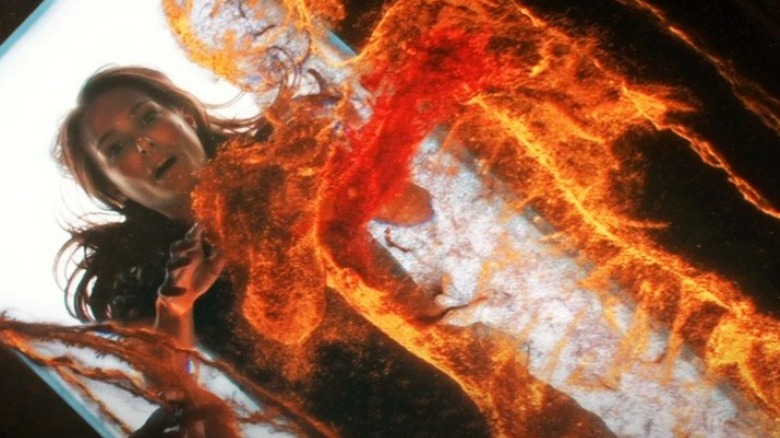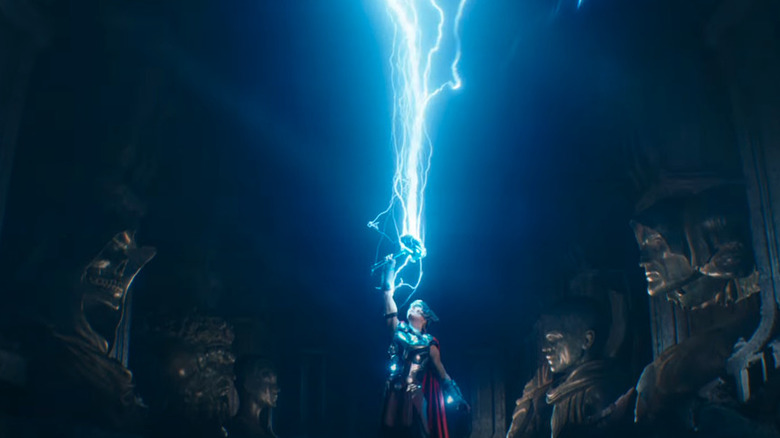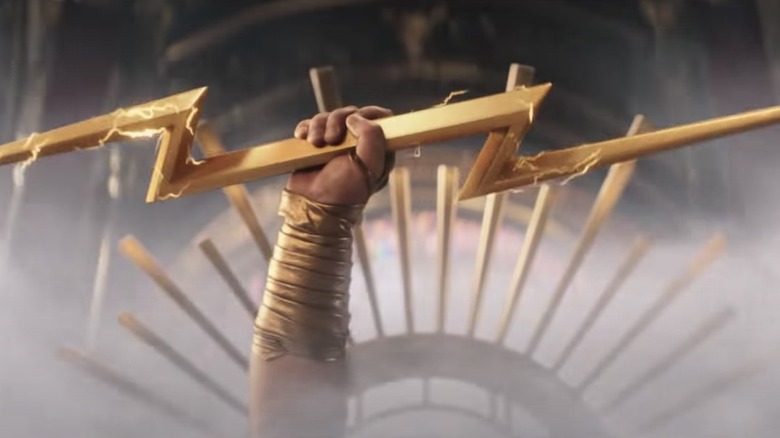Easter Eggs You Missed In Thor: Love And Thunder
With hundreds of issues of comic books and thousands of years of mythology to pull from as potential source material, the MCU's "Thor: Love and Thunder" can't help but call back to the pop-cultural and historical markers that came before it. The fourth solo Thor film, once again co-written and directed by Taika Waititi, combines a variety of disparate influences to create a take on the character and his world that's bold, fun, heartwarming, and above all else, tonally unique in the superhero space. However, despite its singular vibe, homages to its many influences can be found throughout the movie.
Waititi and company pay subtle tribute to real Viking history and legend, comics dating back to the 1960s, previous MCU plotlines, and the entertainment industry itself. Several plot points, characters, shot compositions, costumes, lines of dialogue, and music cues have more meaning than you might think. Some of the references are a bit tongue-in-cheek, others work like literary devices, and — as has become the norm for the MCU — some add more context to prior films. These are the Easter eggs you might have missed while sitting back and enjoying the goat boat ride that is "Thor: Love and Thunder."
The soundtrack foreshadows the plot
The first time audiences saw (and heard) the long-awaited teaser trailer for "Thor: Love and Thunder," they couldn't help but notice the familiar sound of Slash's guitar. Guns N' Roses' hit "Sweet Child O' Mine" wailing in the background promised that the film would lean into a 1980's hard rock aesthetic. As it turns out, quite a few of the band's bangers made their way onto the soundtrack, but the carefully chosen music doesn't just set the mood. As he did with his Grammy-winning soundtrack for "Jojo Rabbit," Taika Waititi has selected songs that convey both a feeling and a story.
"Paradise City" plays as Thor departs for Omnipotence City, but it's not just the title that fits. The lyrics of "Paradise City" makes a reference to Captain America, and to a broken-hearted man who is a "court jester" now. There's even a reference to blindness and to not being believed. Thor has become a progressively more comedic character, he lost an eye in "Thor: Ragnarok," he's heartbroken over Jane, and Zeus — alongside all the other gods — won't listen to his warnings about Gorr.
Similarly, "November Rain" is about breaking up and getting back together and accepting that nothing — including love — can last forever, which mirrors his and Jane's relationship and predicts her untimely death. However, the most obvious example is "Sweet Child O' Mine," an uncharacteristically tender and innocent rock anthem that includes lyrics about prayer and thunder. Its prominence — especially in the marketing — foreshadows that Thor would adopt Love, Gorr's resurrected daughter, without us even knowing it.
There's a What We Do in the Shadows cameo
Like many directors (Sam Raimi, Wes Anderson, and Judd Apatow, to name just a few), Taika Waititi likes to give featured roles and cameos to trusted friends and actors whom he's worked with before. In Waititi's case, this often means fellow New Zealanders. He's collaborated on multiple occasions with Sam Neill, Rachel House, Jemaine Clement, and Rhys Darby. He told Radio Times, "You know, I often put in a lot of my actors from my other films... that for me makes it more of my film." Neill and House had cameos in "Thor: Ragnarok," and this time, it's Jonathan Brugh's turn.
Brugh was Waititi's co-star in the 2014 film version of "What We Do in the Shadows," the vampire mockumentary that's now a cult-hit TV series. Brugh plays Deacon, the youngest vampire in the household at 183 years old, who's cool compared to Waititi's 379-year-old uptight dandy of a bloodsucking immortal. In "Thor: Love and Thunder," Brugh is — theoretically — immortal again, portraying Rapu, the god that forsook Gorr and his people.
The scene in which Gorr and Rapu come face to face is high stakes, as it has to establish Gorr's motivation, although it's played for both drama and comedy. Brugh's Rapu is so flippant and callous that he crushes Gorr's soul by admitting with a shrug and a laugh that religion is basically a sham. Then, he's too full of himself to sense that he's about to get stabbed in the throat with the Necrosword in retaliation.
The actors' kids are in the movie
Unless you were paying really close attention to the credits, you might not have noticed that there's more than one Hemsworth, Bale, and Waititi in "Thor: Love and Thunder." All three actors, as well as Natalie Portman, involved their children in the making of the movie, which was probably a nice way to keep families together as the film was produced during the COVID-19 pandemic with quarantine measures in place.
Hemsworth's son Tristan plays young Thor (there's also a baby and a teenage Thor, for context) who goes running through the woods in a montage that shows the God of Thunder growing up. Tristan's twin, Sasha, is one of the Asgardian children who gets captured by Gorr. Older sister India Rose portrays Love, Gorr's daughter who's brought back to life, which makes that final scene between Love and Thunder all the more charming. Portman's kids, Aleph and Amala Millepied, are also among those kidnapped and used as bait by Gorr, as are Taika Waititi's daughters, Te Kainga O'Te Hinekahu and Matewa Kiritapu. Bale's children — Emmeline and Joseph — are in the cast as well.
Since family and community are major themes in "Thor: Love and Thunder," it's sweet that these superstar parents were able to share this experience with their kids, especially since — in Bale's case — the kids were who insisted he take the job.
Thor's hat reveals his insecurity
As Korg explains, Thor hits the Norse god's version of the gym and goes from dad bod to god bod in an attempt to remedy his existential crisis. While working out with some comically enormous battle chains, Thor wears a grey undershirt, red sweatbands, and a trucker cap with a graphic that reads "The Avengers" with the names "Thor," "Ant-Man," "Hulk," and "Iron Man" in red star bubbles overhead. Like a petulant child, Thor has crossed out the three names that aren't his, plus the word "the." Beyond that, he's scribbled the word "strongest" in sharpie, so the hat now says "Thor! Strongest Avenger."
This is a callback to a scene from "Thor: Ragnarok" that wounded the God of Thunder's self-esteem. When he tries to restart the Quinjet that Hulk crashed on Sakaar to escape, he finds that he has to use voice recognition software to unlock the system. He says "Thor," then "Thor, son of Odin," then "God of Thunder" to the computer screen, which buzzes as if the password is incorrect each time. Finally, he tries "strongest Avenger" twice, but that's not right, either. Once Hulk turns back into Bruce Banner, the computer system greets him as the strongest Avenger. Apparently, Thor, son of Odin and the God of Thunder, still hasn't gotten over it.
The Asgard Players are now performing Thor: Ragnarok
"Thor: Ragnarok" was, in a way, a reset of a character who had been more stoic and straightforward in previous installments. Taika Waititi's fresh, frenetic, and much funnier take on the Norse god was appreciated by audiences, and he achieved that level of playfulness by writing bits like the play Loki (disguised as Odin) commissions to retell the legend of his own death. The gag effectively satirizes previous Thor stories, and it's made even more uproarious by the fact that Matt Damon, Luke Hemsworth, and Sam Neill are doing their best worst acting as Loki, Thor, and Odin.
It's a treat that they're back for "Thor: Love and Thunder." Their cameos are pretty obvious as far as Easter eggs go, but the content of their new production is worth paying close attention to. The Asgard players have set up shop in the tourist destination of New Asgard, where they're currently performing the events of "Thor: Ragnarok" as amusement park entertainers. Their little play gets most things right, minus the sparring wit between the princely brothers, albeit with the budget of a high school musical.
Thor and Loki are on a cliff overlooking the sea wearing tearaway suits that transform into their superhero costumes. Odin leaves this world in a puff of confetti while Neill belly crawls offstage. Hela bursts through a paper portal in something approximating her real headpiece and outfit. Mjolnir flies through the air on a wire. It's all perfectly calibrated to mythologize the last movie while maintaining Waititi's irreverent auteur touch.
Ben Falcone is directing Melissa McCarthy
Moviegoers probably noticed that Melissa McCarthy has been cast as Hela in the New Asgard players production of "Thor: Ragnarok." What they might not have noticed is that her real-life husband, Ben Falcone, joins the cast during curtain call as the stage manager. This is an in-joke on two levels. McCarthy and Falcone, who've been married since 2005, are the founders of a company called On the Day Productions. Falcone has either written, directed, or produced many of the On the Day Productions films in which his wife has received top billing. He is also an actor who has appeared alongside McCarthy in films like "Bridesmaids," "Identity Thief," and "The Heat."
McCarthy and Falcone should get some comedy points for being able to poke fun at themselves. Though both are talented and have been a part of many successful movies, their track record isn't so hot when they work together. Most of their collaborations haven't gone over well with critics or audiences. For example, they teamed up for the off-brand superhero movie "Thunderforce," which was panned in reviews for being generally unfunny, too broad, and crass, all while failing to make good on its parody of a comic book movie premise. As such, there's something a little cheeky about Falcone being in charge of New Asgard's cringey theatrical offerings, which now star his spouse doing some purposefully second-rate work.
Falligar's death is straight from a comics panel
When the much-anticipated teaser trailer for "Thor: Love and Thunder" finally dropped, one shot caught the attention of fans who were well-versed in Thor comics. It was already known that the plot would follow Thor's efforts to stop Gorr the God Butcher from exterminating the gods, himself included. The storyline is largely borrowed from Jason Aaron and Esad Ribic's run with the character in "Thor: God of Thunder," which began in 2012 and quickly became a fan favorite. In fact, the main changes are mostly omissions, a condensed timeline, and some tweaks to character designs. Gorr still becomes the God Butcher after his last child starves, he starts by killing a golden god, and it takes multiple Thors to defeat him. In both the comics and the film, Falligar the Behemoth is one of his victims.
In showing us what became of Falligar, Waititi composed a shot that's nearly identical to a panel from "Thor: God of Thunder" # 3 (via ComicBook). The mountainous body of the god of the Galactic Frontier lies on its side with its mouth agape and blood trickling from its nostrils while its rocky, icy spikes point diagonally to the sky. Thor stands on the taller of two snow-covered monoliths, distraught at the death of his friend at the hands of Gorr, who's still out there on his quest to kill every last god. The only difference is the addition of Korg in the movie version, who isn't accompanying Thor on this particular adventure in Aaron and Ribic's pages.
Tonsberg really was a Viking commercial hub
The village of Tonsberg has been a part of the Marvel Cinematic Universe dating back to 2011's "Thor." In that film, audiences see Odin and the Asgardians defend it against the Frost Giants who want to take over the nine realms, starting with this seaside outpost in 965. When Asgard falls in "Thor: Ragnarok," the Norse gods relocate to Tonsberg and rename it after their own realm. Fast forward to about 2025, and New Asgard is a Disney World-like tourist destination with relics, rides, shows, souvenirs, and cruise ships lining the shore. King Valkyrie and Miek — both wearing smart business suits — preside over this booming economy.
Part of the commentary here is that modern humans can commercialize anything, including Space Vikings who saved our world and lost theirs in the process. It's some clever meta-humor since "Thor: Love and Thunder" will presumably sell millions of dollars of its own merch, from Legos to lunchboxes. There's also an Avengers Campus in Disney California Adventure park where guests can pose for pictures with the God of Thunder.
However, using Tonsberg as the MCU's New Asgard is also evidence of good research. Tonsberg, a real place with about 32,000 residents, is the oldest city in Norway with deep connections to Viking history. If you visit, you'll see two Viking ships dating back to the 9th century on display in the harbor. The port city was a vital trading hub then and is a modernized commercial center and a tourist stop now.
The goats come from the comics and mythology
In "Thor: Love and Thunder," our hero acquires his new pets as a traditional gift of thanks from King Yakan after he drives off invaders. Thor thinks they're "wonderful," but Korg worriedly remarks that they "scream quite a lot." Too much of the goats could've been annoying, but the film milks them for just the right amount of comedy. Supersized screaming goats are exactly the kind of nonsensical yet hysterical flourish that you might expect from a Taika Waititi movie, but these creatures actually first appeared in Marvel comics in the 1960s, and their mythological legacy dates back to the 1200s.
Their names are Toothgnasher and Toothgrinder, and — as is their purpose in "Thor: Love and Thunder" — they started out as a joke. Loki tricks his brother into thinking that everyone would be impressed if he could tame goats instead of horses, which earns the God of Thunder ridicule instead of respect. However, Thor and his trusty horned steeds have the last laugh, as Toothgnasher and Toothgrinder are imbued with magic. Not only can they easily pull their master's chariot on land, in the air, through space, and to alternate dimensions, but they're also intensely loyal, can communicate with Thor, and can be resurrected by Mjolnir.
The Thor of Norse mythology has two mystical goats, too. Tanngrisnir and Tanngnjóstr make their debut in the Poetic Edda, in the passages that depict Thor's journey to Utgard. A poor farmer bestows them upon him, as they can be eaten then resurrected so long as their bones aren't broken. As a result, Thor is often depicted with his two goats in art.
Jane explains science the way Thor once explained it to her
Thor and Jane Foster meet cute in "Thor" when she, Darcy, and Dr. Erik Selvig nearly run him over as they're chasing a thermonuclear storm. Initially, she mistakes his confusion at Earth's people and customs as mental illness, but slowly, she starts to believe that there might be some truth to his incoherent seeming ramblings. After he recovers her stolen research notebook from S.H.I.E.L.D., he encourages her to continue her work, assuring her that her theories are right. Thor opens the notebook and fills in the gaps, explaining that in his world, magic and science are the same. What she's really studying is Yggdrasil, the world tree that connects the nine realms (bonus Easter egg: as Mighty Thor, Jane's blue lightning resembles Yggdrasil).
In "Thor: Love and Thunder," there's a scene that mirrors the one from "Thor," only with Jane's role reversed. She went on to publish a book about Einstein-Rosen bridges (a real concept in our world) based in part on what she learned from her ex, which a fellow cancer patient happens to be reading while seated next to her during their chemo treatment. Jane can't help herself from introducing herself as the author. Then, as Thor had done, she grabs the book and uses it to explain how it all really works. However, instead of doodling, she folds the pages in on themselves and punches a hole through them.
Jane also adds that the film "Interstellar" does a good job at illustrating Einstein-Rosen bridges, which is its own Easter egg, as Smithsonian Magazine notes that the film has been cited by scientists for its relative accuracy.
The Thors sport comic accurate looks
For most of his appearances in the MCU, Chris Hemsworth's Thor has dressed a little more scantily and casually than his comics counterpart. From "Thor" to "Avengers: Age of Ultron," his costumes are like muted versions of 2007's "Thor" comic book reboot (heavy on chainmail) and 2002's "The Ultimates" (monochromatic with bare guns). However, the MCU's Thor spends a lot of time in tank tops, hoodies, and leather vests, and Marvel Studios has been hesitant to cover Hemsworth's flowing blonde locks and close-up-worthy face. As such, he's rarely been outfitted with a headpiece on film, even though he regularly wears one in print.
"Thor: Love and Thunder" puts Hemsworth (and the other actors who play the character) through a whole fashion show's worth of costume changes. Among them are some vintage looks that fans have been waiting to see brought to life on the big screen. In the montage that plays as Korg narrates, a teenage Thor wearing Jack Kirby's original 1962 design can be seen running through a sunlight forest, complete with a silver winged helm.
Later, when Thor sees Jane in her Mighty Thor get-up, he switches to more colorful red, gold, and blue armor, featuring a geometric, heavy-duty helmet that obscures everything except his eyes and mouth. Hemsworth doesn't keep it on for long, but this costume could be a throwback to "Thor" #44, in which the character adopts a new helmet that's a combination of his own and his father's. As Odin is gone and Thor is being called to serve again, it's an appropriate choice. Finding ways to get superheroes in their comic book costumes seems to be a running theme in Phase 4.
Valkyrie wears a Phantom of the Opera sweatshirt
King Valkyrie is a character torn between her administrative responsibilities on Earth as New Asgard's leader and her thirst for adventure. She looks bored in "meetings that could've been raven mail," starring in Old Spice commercials, and attending ribbon-cutting ceremonies, which is why she jumps at the chance to ride her Pegasus into battle against Gorr's Black Berserkers. However, the shadow beasts arrive suddenly and unexpectedly, which is probably why the Asgardian warrior didn't have time to change out of her comfy human clothes.
Valkyrie fights next to Thor, Mighty Thor, Korg, and a small army of brave New Asgardians in an oversized "The Phantom of the Opera" sweatshirt. The uber-popular Andrew Lloyd Webber show, which is the longest-running musical in history, is certainly a relevant enough pillar of pop culture to warrant shout-outs, although it doesn't have any obvious connections to Marvel or Norse mythology.
This reference, which is both hard to miss and hard to interpret, is all about Tessa Thompson. As actors often do, Thompson imagined a rich backstory for her character. She reasoned that while living amongst humans, Valkyrie would've taken an interest in some of their hobbies, and Thompson decided that Valkyrie became a fan of musical theater and basketball. She can also be seen in a New Asgard basketball jersey in the film. Thompson got her start on the stage, though not in musicals — she was a renowned Shakespearian actor prior to her work in television and film.
Miek has undergone some changes
"Thor: Ragnarok" brought a multitude of new characters into the MCU, including Hela, Skurge, Valkyrie, the Grandmaster, Korg, and Miek. Korg and Miek, who provided some of the film's most memorable moments of comic relief, quickly became fan favorites. The former has a much larger role in "Thor: Love and Thunder," where he's become Thor's "best friend" as they adventure with the Guardians of the Galaxy, while the latter has been serving in King Valkyrie's administration. Korg's personality and physiology are fairly easy to grasp (he's an affable rock guy), while Miek's require closer inspection.
The character first appeared in "The Incredible Hulk" #92. In the comics, Miek is a Sakaaran who can metamorphose and becomes enslaved after his family is murdered. The Miek we meet in "Thor: Ragnarok" is being held captive by the Grandmaster and forced to fight in his gladiator pits. His body's been retrofitted with a metal exoskeleton that's given him blades for hands. However, in "Thor: Love and Thunder," Miek's undergone quite a transformation.
The purple insectoid is female now. She wears a skirt suit with a blouse with a bow at the neck. There's precedence for this in the comics, too. At one point, due to exposure to chaos energy, Miek switches genders and can lay eggs. Taika Waititi has also given her some new appendages. Presumably for her duties as King Valkyrie's assistant, her exoskeleton has been updated with dry erase markers which she uses to take notes during Thor's speech.
Omnipotence City is full of real gods
When fans first caught a glimpse of Zeus in the trailer for "Thor: Love and Thunder," most assumed he was ruling over Olympus. But that floating, golden paradise is actually Omnipotence City, a billions-of-years-old retreat for the gods that has its roots in Marvel comics. Omnipotence City is a better choice of setting for a story about a villain who wants to kill all gods, and not just the Greek or Norse ones. Thor and Zeus aren't the only immortals that Marvel has tapped for superherodom. The deities of civilizations throughout history — Aztec, Mayan, Inca, Hindu, Polynesian, Egyptian, Roman, Norse, Slavic, Celtic, Chinese, Japanese, Native American, and Inuit — have made it into the pages of comic books.
Many of these gods can be spotted in the background of this scene in "Thor: Love and Thunder." They vary wildly size and appearance, and since most don't have speaking roles, we can't say for sure who, exactly, they're all meant to be. The credits list Artemis and Minerva by name. There's also an Aztec god, Elche god, Maori goddess, Mayan god, Jademurai god, plus whole sections of Greek and Egyptian gods, as well as a Goddess of the Dead, each wearing the distinct costumes of their heritage.
However, as this is a comic book movie and not historical fiction, viewers will also notice Bao, the God of Dumplings, a god that's just a furry head and feet, and Korg's Kronan god (also played by Taika Waititi). Since "Moon Knight" recently brought world culture-based gods into the MCU, we can probably expect to see more of them in the future.
That's Dionysus
One of the gods who does get a line of dialogue is Dionysus, played by Simon Russell Beale. If you know who this god is, it makes sense that he's been singled out for a speaking part and is seated in a place of prominence. Omnipotence City in "Thor: Love and Thunder" is a den of revelry, pageantry, debauchery, and little concern for the rest of the universe. Zeus (and it seems most of the rest of the gods in attendance) is mainly concerned with bragging about how many followers he has and planning the next orgy. When the camera pans down to the Greek delegation, who faithfully supports him over Thor, we see a man in a toga drinking out of a chalice. This is Dionysus, the god of wine, who is also Zeus's son.
Dionysus is basically the patron saint of letting loose and having a good time. He's associated with festivals that celebrate the harvest and fertility, at which people were known to get pretty freaky and intoxicated. Having Dionysus in the crowd is narratively symbolic since Thor is frustrated that the gods won't stop their partying and take him seriously when he warns them about Gorr's intentions. If you stuck around after the ending, you know that we meet another of Zeus' kids when Hercules shows up in the mid-credits stinger.
There's hidden meaning behind Thor's moon
Further proof that Omnipotence City is more of a pleasure palace than a strategic fortress is Thor's disrobing. When the God of Thunder decides to speak up about the coming threat of Gorr the God Butcher, Zeus — in an attempt to embarrass him — flicks off the blue robe he'd been using as a disguise. The punishment doesn't have the desired effect. All the men and women in Zeus's harem faint from the sight of the Norse god's naked body, while Valkyrie and Jane clink their glasses and decide to wait a minute before intervening.
There are two obscure references hidden in Zeus and Thor's salacious spat. The word "flick" was previously used by Ant-Man when he tells Tony Stark to flick him in "Avengers: Endgame" as he bends over. This time, Thor tells Zeus that he "flicks too hard" when his undergarments fly off with his robe. The word "flick" in all-caps comic sans can be easily mistaken for a certain curse word that also begins with F, so the double use of the term in this scene is a covert dirty joke.
Similarly, Taika Waititi has a track record of his showing his actors' bare behinds in movies. In "Thor: Ragnorok," it was Hulk whose backside was visible as he looked out the window of his apartment on Sakaar. This time, it's Thor's turn to moon the Marvel Cinematic Universe's audience. At least Mark Ruffalo's Hulk was CGI — Thor is Chris Hemsworth, in the flesh.
Thor's new tattoo is a tribute to Loki
Yet another Easter egg can be observed in the Omnipotence City scene when Thor's bare back is exposed. The God of Thunder has gone shirtless in the MCU before, but he's never had any tattoos. As recently as 2019's "Avengers: Endgame" — when he was going through some stuff and had put on some weight — Thor's body still hadn't been inked at all. But when Zeus flicks off his robe, a whole collage of tattoos can be seen from shoulder to shoulder. There's a scroll and a broken heart, but in the dead center is the unmistakable horned helmet of his adopted brother Loki.
If you've been keeping up with the MCU and its expansion into television, you're probably aware that the Loki who died in "Avengers: Infinity War" is still dead. However, the Loki from the past, who crossed paths with the Avengers during their time travel in "Avengers: Endgame," is the one who starred in "Loki" on Disney+. There are a myriad of variant Lokis out there as well, but Thor knows nothing about any of them. Though they've had a complicated and often adversarial relationship, it's sweet that Thor permanently memorialized his late brother this way.
Jane and Thor disagree about how long it's been
As Jane and Thor awkwardly navigate hanging out as exes, she wonders how long it's been since they've last seen each other. Her guess is three or four years. With much more certainty, he says, "eight years, seven months, and six days, give or take." This exchange serves two purposes. It lets us know that Thor is pining for Jane a little harder than she's pining for him since she estimates and he's so specific. But their answers — which are pretty far apart — are also consistent with the fact that Jane was blipped and Thor was not.
The last time Earth-616's Jane and Thor shared the screen was in 2013's "Thor: The Dark World," but it's implied they stayed together a while longer, at least through 2015's "Avengers: Age of Ultron." By 2017's "Thor: Ragnarok," Thor is assuring Loki that he dumped her, not the other way around. The new film gives us much more insight into their relationship through a pretty adorable montage in which the God of Thunder wears a hot dog costume for Halloween. Sadly, that scene ends with Jane writing a goodbye letter after Thor stands her up, which results in neither party really knowing who initiated their split.
The current phase of the MCU takes place five-plus years after the blip, which occurred in 2018. "Thor: Love and Thunder" doesn't deal with the fallout and is probably set around 2024 or 2025. That means they called it quits in late 2016 or early 2017, making it nearly nine years from his perspective but five fewer from hers.
Magic complicated Jane's cancer
In both Marvel comics and the MCU, Jane Foster loses her mother to cancer at a young age, then becomes a victim of the disease herself. "Thor: Love and Thunder" relies upon context clues to tell this tragic story, but the print inspiration provides more explanation. In the comics, Jane is diagnosed with cancer. When Mjolnir calls her to become Mighty Thor, she feels healthy and strong. But its magic zaps her body of toxins, including the chemotherapy that was targeting the cancer cells. Thus, Jane's cancer actually progresses faster each time she picks up Thor's hammer until she ultimately dies.
In the film, her inner circle — Erik Selvig, Darcy, and Thor — merely mentions that treatment isn't working, and they eventually figure out that Mjolnir isn't helping. We know how the hammer affected her condition and that she waited too long to see doctors, but the movie tells us less about the cancer itself. While it's certainly possible it's the result of genetic predisposition, it's also possible that it's related to her exposure to the aether in "Thor: The Dark World." Jane became infected with the Reality Stone in its liquid state, and its immense energy nearly killed her before Thor outsmarted Malekith into drawing it out of her.
In the comics, as in the film, Jane is welcomed into Valhalla. Since the comic book version of Mighty Thor is involved in storylines about incursions (which were introduced in "Doctor Strange in the Multiverse of Madness"), there's a slim chance we might see her in the MCU again.
Look out for Celestials, the Living Tribunal, and the Watcher
The Marvel Cinematic Universe started audiences off easy with 2008's "Iron Man," starring Robert Downey Jr., which is about human characters from our world. Now, MCU movies and TV shows have gotten decidedly weirder. From Alligator Loki to Zombie Strange, our generally accepted rules about time, space, and the nature of life itself no longer apply. Characters who can be kind of difficult to wrap your head around — like Celestials, the Living Tribunal, the Watcher, and Eternity — are now a part of the overarching narrative, and they all have cameos (sort of) in "Thor: Love and Thunder."
Celestials technically made their debut with Ego in "Guardians of the Galaxy Vol. 2," but we got to know them better and see them in their true form in "Eternals." Two Celestials guard the entrance to Omnipotence City, and one's head crashes down after a fight. As far as the other all-powerful but hard-to-describe entities go, some interesting statuary busts line the cavernous room that leads to Eternity's gate. One looks suspiciously like the Living Tribunal, the cosmic embodiment of impartial judgment whose distinctive triple-faced, hooded statues can also be seen in fleeting shots in "Loki" Episode 5 and "Doctor Strange in the Multiverse of Madness."
Another resembles the Watcher — who appeared in the animated series "What If?" voiced by Jeffrey Wright — a being who observes everything that happens in the multiverse but never interferes. It's probably more than just a coincidence that production designers adorned the set with these enormous bronze heads.
Another lightning thief?
Mythology and fantasy fiction have been closely intertwined for thousands of years, from Homer's "Odyssey" to Marvel comics. "Thor: Love and Thunder" isn't remotely the first movie, let alone story, to use gods like Zeus as characters. It's also not the first in which Zues' lightning gets stolen. For instance, Rick Riordan's extremely popular 2005 young adult "Percy Jackson" novel, "The Lightning Thief," covers similar territory. In that book, the title character has to recover Zeus' bolt after another character makes off with it. There's unrest between the gods and demi-gods, and some folks believe that they've become unfit to rule and must be stopped.
Things happen a little differently in "Thor: Love and Thunder." Thor's team steals the bolt to help them defeat Gorr, who wants the indifferent gods dead, but Thor has to use it to (seemingly) kill Zeus so they can escape when he tries to imprison them. Zeus's lightning bolt is considered to be one of the most iconic and powerful weapons in mythology and genre fiction, so the overlap between the fourth Thor movie and the "Percy Jackson" series isn't necessarily intentional. However, Disney owns the rights to both, and a new "Percy Jackson" TV series is coming soon to Disney+, where the two "Percy Jackson" film adaptations can also be streamed. So the golden bolt and the shared subject matter might be some sly (or even subconscious) corporate synergy.
